
🧪 The Campbell lab at UTokyo is looking to hire a postdoctoral researcher for a project focused on protein engineering for optogenetic tool development. Details here: www.s.u-tokyo.ac.jp/en/recruit/?...
25.11.2025 00:40 — 👍 7 🔁 4 💬 0 📌 0@campbell-lab.bsky.social
Professor in the Department of Chemistry, School of Science, The University of Tokyo. Editor-in-Chief of Protein Engineering, Design & Selection (PEDS). Opinions are my own. https://campbell.chem.s.u-tokyo.ac.jp

🧪 The Campbell lab at UTokyo is looking to hire a postdoctoral researcher for a project focused on protein engineering for optogenetic tool development. Details here: www.s.u-tokyo.ac.jp/en/recruit/?...
25.11.2025 00:40 — 👍 7 🔁 4 💬 0 📌 0Thanks! Preprint is here: doi.org/10.1101/2025...
08.09.2025 22:59 — 👍 23 🔁 6 💬 0 📌 0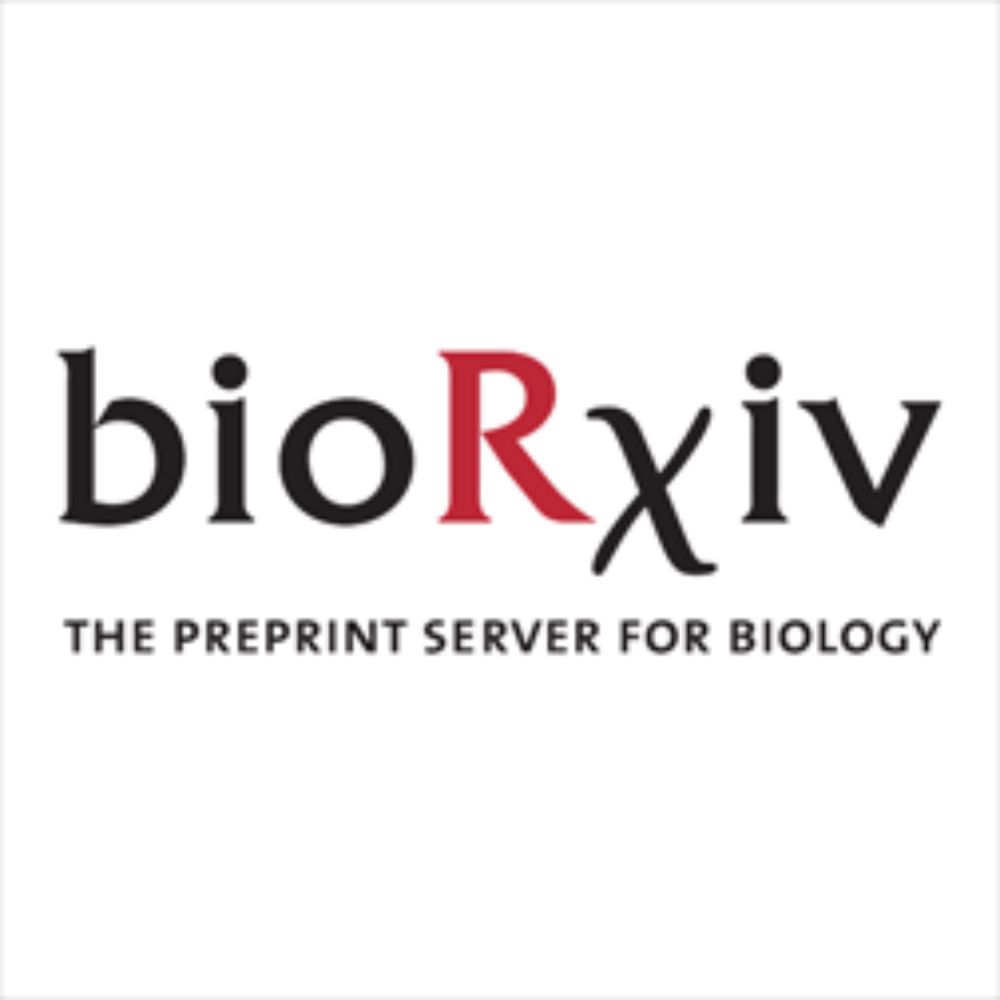
#OCaMP is now on bioRxiv and reagents are available on #Addgene! 🧪
A sensitive orange fluorescent calcium ion indicator for imaging neural activity
www.biorxiv.org/content/10.1...
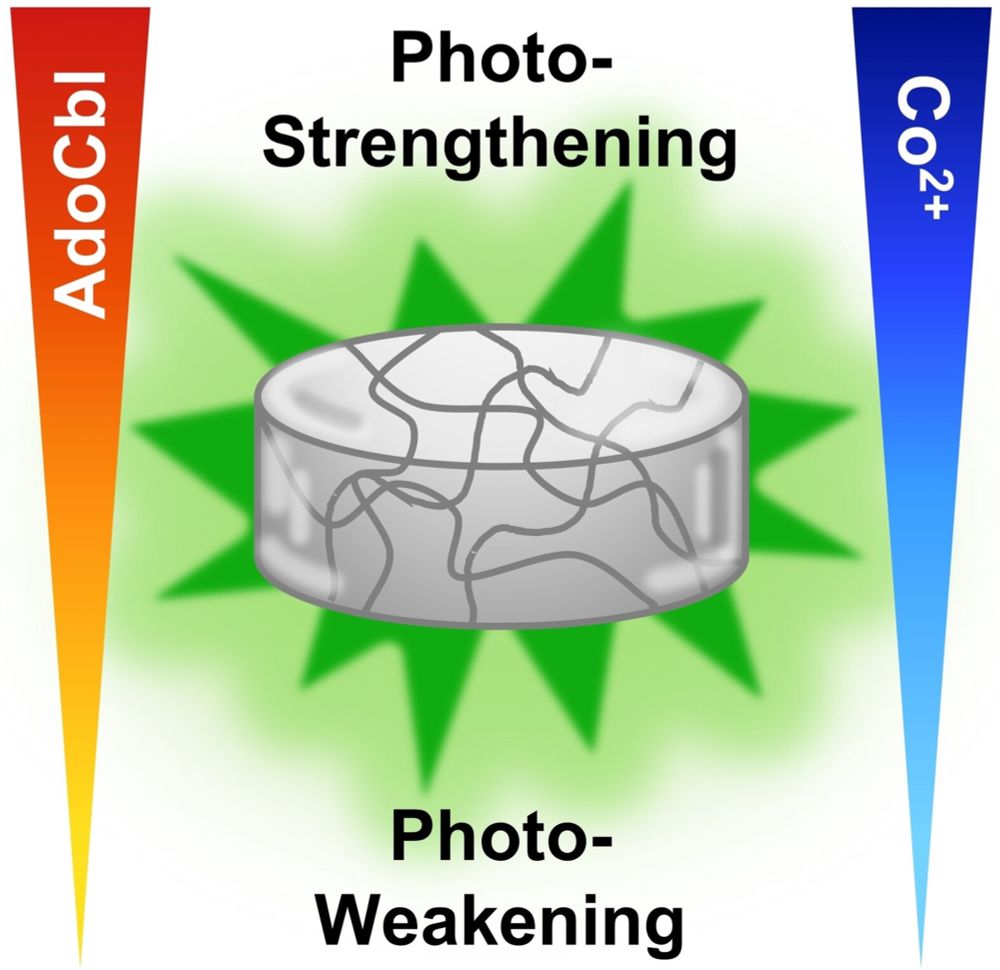
Huge congratulations to Saskia on her first first-author paper! 🥳
chemistry-europe.onlinelibrary.wiley.com/doi/full/10....
For sure! With a suitable calibration curve, quantitative measurements with the purified biosensor, added to cell lysate, could be straightforward.
26.06.2025 06:38 — 👍 2 🔁 0 💬 0 📌 0Boost your metabolism (research) with 🍎🥧 pyruvate biosensors, now available on Addgene! Green ones and red ones, with a range of affinities. www.addgene.org/browse/artic...
25.06.2025 05:20 — 👍 14 🔁 4 💬 0 📌 0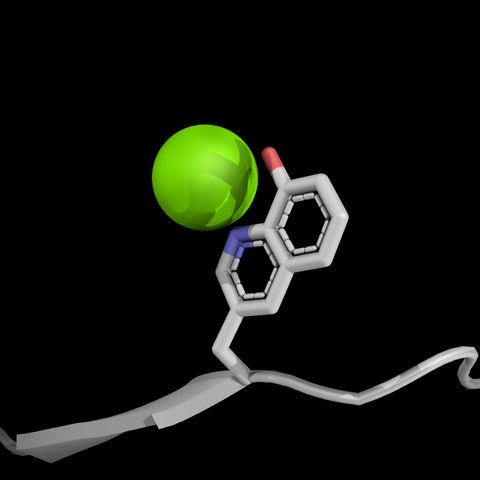
Non-canonical amino acid from PDB ID 8W3Z shown chelating to a magnesium ion. Image made with PyMol. https://www.rcsb.org/structure/8W3Z https://www.pymol.org
Protein Engineering, Design & Selection (PEDS) invites contributions to a Special Collection titled, “Non-Canonical Amino Acids", with guest editors Prof. Huiwang Ai (Virginia) and Prof. Peng Chen (Peking). Send us your best work!
academic.oup.com/peds/pages/c...

New tools! GreenPy and ApplePy are fluorescent biosensors for pyruvate with huge responses (20–40x in vitro) and a range of affinities (10s of μM to mM). These should be game changers for imaging of metabolism! Great work by Shosei Imai @sikmys.bsky.social and team 👏. www.biorxiv.org/content/10.1...
19.04.2025 06:42 — 👍 91 🔁 36 💬 4 📌 0
I am delighted to share that I have taken on the role of Editor-in-Chief of Protein Engineering, Design & Selection. From the dawn of molecular biology to the current golden age of protein engineering, PEDS has been a cornerstone of the community. Send us your best work! academic.oup.com/peds
08.04.2025 06:42 — 👍 12 🔁 2 💬 0 📌 0🚨iGluSnFR4 is finally out!🚨🧪
We present iGluSnFR4f and 4s, a novel pair of genetically-encoded glutamate indicators designed for high-fidelity imaging of synaptic activity in the living brain. ⬇️
www.biorxiv.org/content/10.1...
🎥 Below: iGluSnFR4s detecting minis in cultures w/ TTX
#Neuroscience
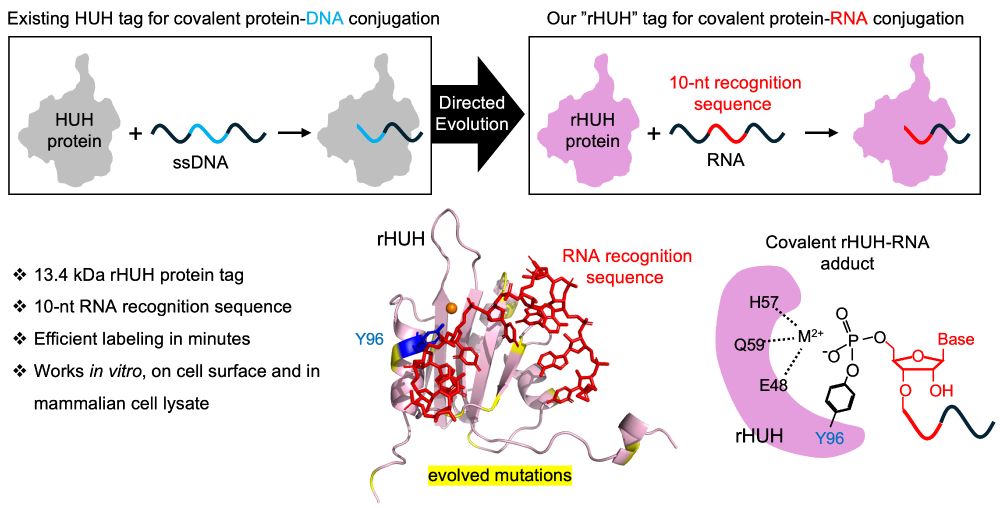
Today we report the directed evolution of HUH into rHUH, a sequence-specific covalent protein tag for RNA labeling. rHUH was hard to engineer: the initial HUH template had no RNA activity, so we started with RNA-DNA hybrids. 30 rounds of selection on the yeast surface were required, and 7 cycles of
26.02.2025 23:21 — 👍 105 🔁 31 💬 3 📌 1First PinkyCaMP plasmids are available via @addgene.bsky.social
www.addgene.org/browse/artic...
Cc @finkryan.bsky.social @massecklab.bsky.social

Poster for ECS Webinar with speakers Robert Campbell snd Sarah Shaykevich.
I, along with Dr. Sarah Shaykevich, will be speaking about red and near-infrared genetically encoded Ca2+ biosensors in the European Calcium Society (ECS) webinar on Wednesday, February 26th at 5 PM CET. This webinar series is open to everyone!
docs.google.com/spreadsheets...
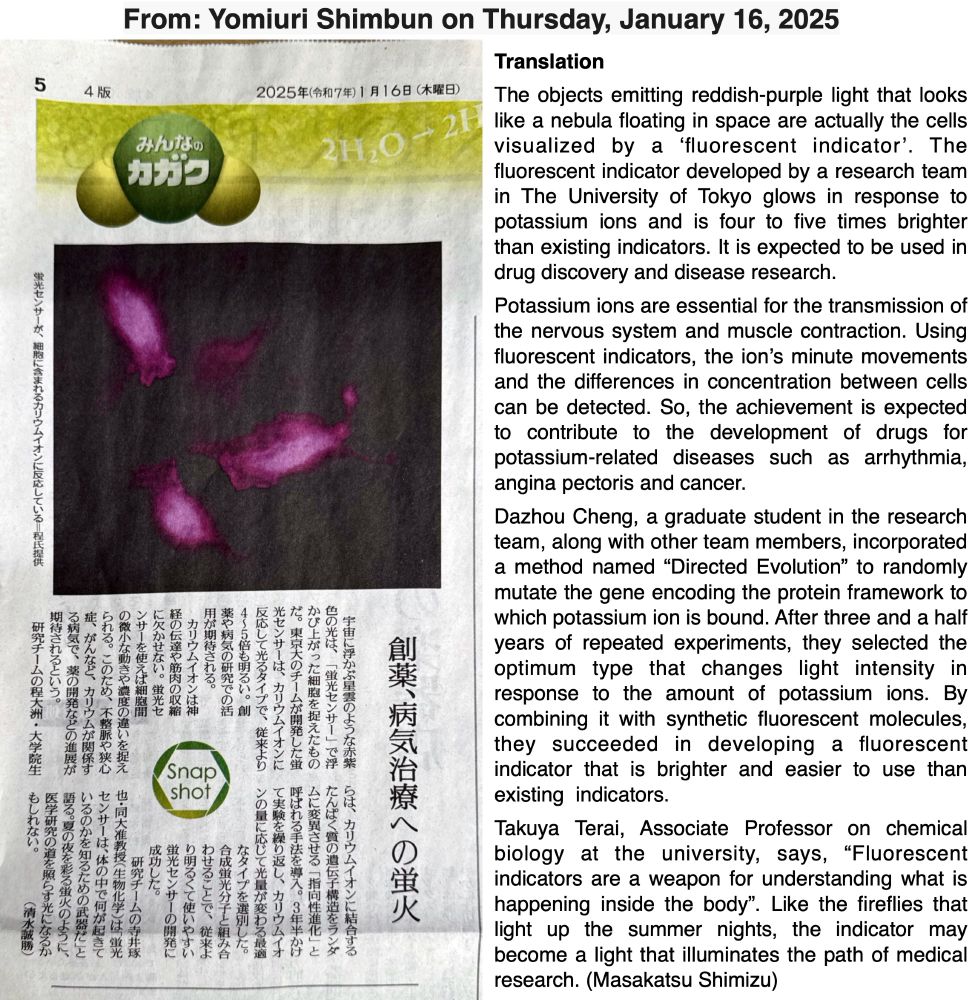
A photograph of a Japanese newspaper article describing chemical biology research. Translation: "The objects emitting reddish-purple light that looks like a nebula floating in space are actually the cells visualized by a ‘fluorescent indicator’. The fluorescent indicator developed by a research team in The University of Tokyo glows in response to potassium ions and is four to five times brighter than existing indicators. It is expected to be used in drug discovery and disease research. Potassium ions are essential for the transmission of the nervous system and muscle contraction. Using fluorescent indicators, the ion’s minute movements and the differences in concentration between cells can be detected. So, the achievement is expected to contribute to the development of drugs for potassium-related diseases such as arrhythmia, angina pectoris and cancer. Dazhou Cheng, a graduate student in the research team, along with other team members, incorporated a method named “Directed Evolution” to randomly mutate the gene encoding the protein framework to which potassium ion is bound. After three and a half years of repeated experiments, they selected the optimum type that changes light intensity in response to the amount of potassium ions. By combining it with synthetic fluorescent molecules, they succeeded in developing a fluorescent indicator that is brighter and easier to use than existing indicators. Takuya Terai, Associate Professor on chemical biology at the university, says, “Fluorescent indicators are a weapon for understanding what is happening inside the body”. Like the fireflies that light up the summer nights, the indicator may become a light that illuminates the path of medical research. (Masakatsu Shimizu)"
Doctoral student Dazhou Cheng's great work on developing a chemigenetic K+ indicator (doi.org/10.1021/jacs...) was featured in the Yomiuri Shimbun daily newspaper!
24.01.2025 08:09 — 👍 7 🔁 1 💬 0 📌 0PhD students and postdoctoral researchers in the UK & Ireland can apply for a JSPS short-term (1-12 month) fellowship to study in Japan. Next deadline is Jan. 20 2025. If you are interested in engineering fluorescent biosensors, feel free to reach out! www.jsps.org/latest_calls...
22.12.2024 06:18 — 👍 2 🔁 2 💬 0 📌 0Congratulations to the whole team! PinkyCaMP is a giant leap forward for red GECIs.
Delighted to have contributed to the protein engineering with graduate student Shosei Imai.
Plasmids have been deposited and should be available soon. Unfortunately, for now we’ve run out of ideas to solve the surface targeting problem.
06.12.2024 03:44 — 👍 1 🔁 0 💬 0 📌 0
UTokyo press release (in Japanese): www.s.u-tokyo.ac.jp/ja/press/105...
05.12.2024 09:47 — 👍 1 🔁 0 💬 0 📌 0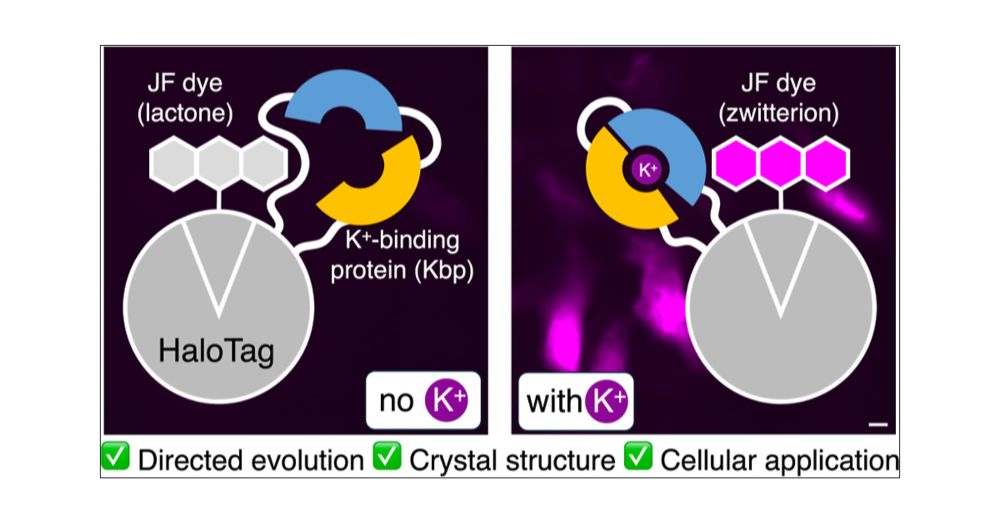
Ph.D. student Dazhou Cheng developed a chemigenetic K+ indicator (HaloKBP), using an rHCaMP/HaloCaMP-type design! pubs.acs.org/doi/10.1021/...
05.12.2024 09:46 — 👍 24 🔁 4 💬 2 📌 0The Asian Chemical Biology Initiative (ACBI) will hold tutorials and student interviews in Hanoi on January 19, 2025. Hope to see you there!
Interested students can get more information and sign up here:
www.asianchembio.com/hanoi-2025-interview
Application deadline is December 1, 2024.
👋
15.11.2024 13:04 — 👍 1 🔁 0 💬 1 📌 0Excited to report an improved green fluorescent extracellular L-lactate biosensor (eLACCO2.1), and a new red fluorescent intracellular L-lactate biosensor (R-iLACCO1), for multiplexed fluorescence imaging! Deep appreciation for a great team of collaborators! rdcu.be/dpB8Y
28.10.2023 02:31 — 👍 15 🔁 1 💬 0 📌 0